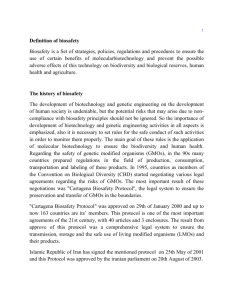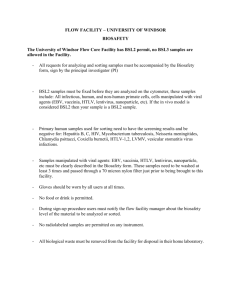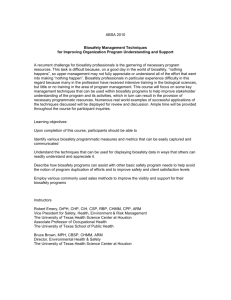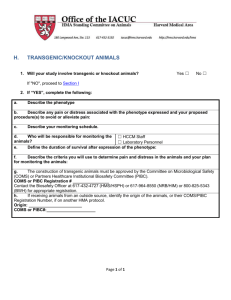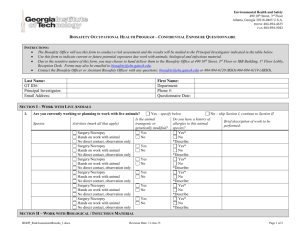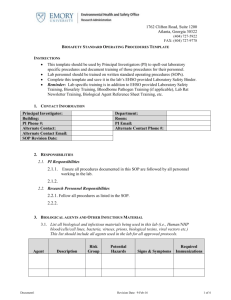Yes No - the Office for Responsible Research
advertisement
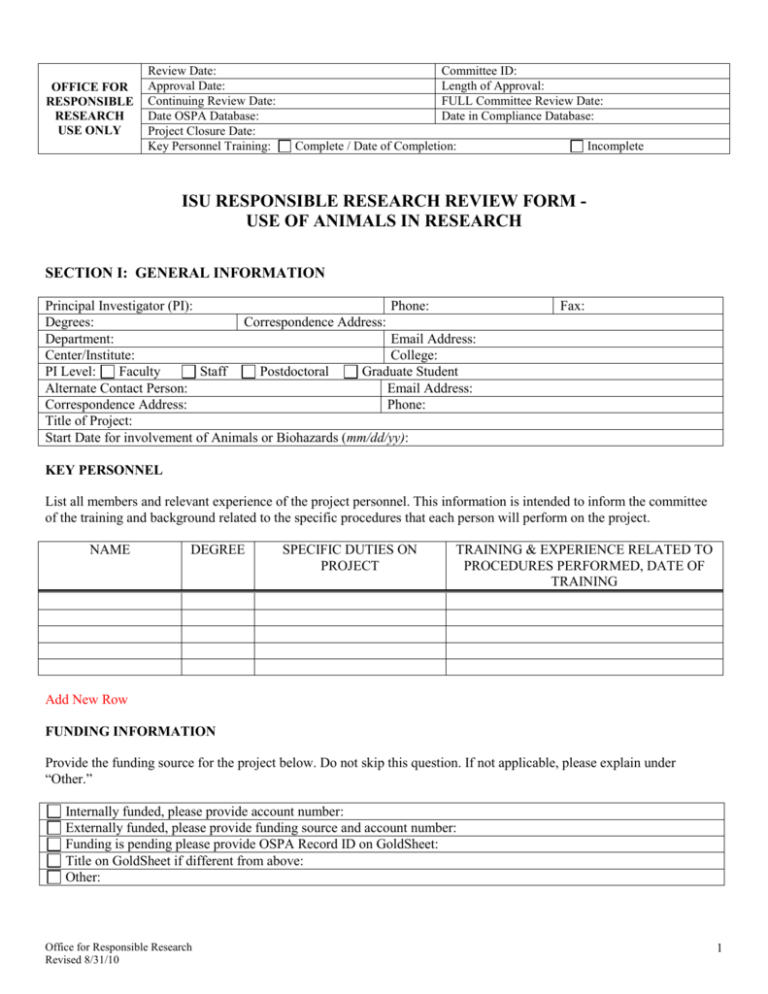
OFFICE FOR RESPONSIBLE RESEARCH USE ONLY Review Date: Approval Date: Continuing Review Date: Date OSPA Database: Project Closure Date: Key Personnel Training: Committee ID: Length of Approval: FULL Committee Review Date: Date in Compliance Database: Complete / Date of Completion: Incomplete ISU RESPONSIBLE RESEARCH REVIEW FORM USE OF ANIMALS IN RESEARCH SECTION I: GENERAL INFORMATION Principal Investigator (PI): Phone: Degrees: Correspondence Address: Department: Email Address: Center/Institute: College: PI Level: Faculty Staff Postdoctoral Graduate Student Alternate Contact Person: Email Address: Correspondence Address: Phone: Title of Project: Start Date for involvement of Animals or Biohazards (mm/dd/yy): Fax: KEY PERSONNEL List all members and relevant experience of the project personnel. This information is intended to inform the committee of the training and background related to the specific procedures that each person will perform on the project. NAME DEGREE SPECIFIC DUTIES ON PROJECT TRAINING & EXPERIENCE RELATED TO PROCEDURES PERFORMED, DATE OF TRAINING Add New Row FUNDING INFORMATION Provide the funding source for the project below. Do not skip this question. If not applicable, please explain under “Other.” Internally funded, please provide account number: Externally funded, please provide funding source and account number: Funding is pending please provide OSPA Record ID on GoldSheet: Title on GoldSheet if different from above: Other: Office for Responsible Research Revised 8/31/10 1 SCIENTIFIC REVIEW Yes No Has or will this project receive peer review? If “yes,” please indicate who did or will conduct the review: If a review was conducted, please indicate the outcome of the review: COLLECTION OR RECEIPT OF BIOLOGICAL SAMPLES Will you be: (Please check all that apply.) Yes No Receiving samples from outside of ISU? See examples below. Yes No Sending samples outside of ISU? See examples below. Examples include: genetically modified organisms, body fluids, tissue samples, blood samples, and pathogens. If you will be receiving samples from or sending samples outside of ISU, please identify the name of the outside organization(s) and the identity of the samples you will be sending or receiving outside of ISU: SECTION II: APPLICATION FOR INSTITUTIONAL ANIMAL CARE AND USE COMMITTEE (IACUC) APPROVAL Yes No Does this project involve live vertebrate animals? If “no” is checked, you don’t need to answer the questions in SECTION II. SECTION III: APPLICATION FOR INSTITUTIONAL BIOSAFETY COMMITTEE (IBC) APPROVAL Yes No Does this project involve any of the following: Recombinant DNA (including transgenic animals); human, plant or animal pathogens; biological toxins; or administration of experimental biological products? If “no” is checked, you don’t need to answer the questions in SECTION III. SECTION IV: ENVIRONMENTAL HEALTH AND SAFETY INFORMATION (EH&S) Yes No Does this project involve laboratory chemicals, human cell lines or tissue culture (primary OR immortalized), or human blood components, body fluid or tissues? If “no” is checked, you don’t need to answer the questions in SECTION IV. ASSURANCE I certify that the information provided in this application is complete and accurate and consistent with any proposal(s) submitted to external funding agencies. I agree to provide proper surveillance of this project to ensure that the health and welfare of animal subjects are protected. I will report any problems to the appropriate compliance review committee(s). I certify that this project does not unnecessarily duplicate previous experiments involving animals. I agree that modifications to the originally approved project will not take place without prior review and approval by the appropriate committee(s), and that all activities will be performed in accordance with all applicable federal, state, local and Iowa State University policies. I will follow applicable biosafety level requirements, comply with all shipping requirements and required waste management practices. Office for Responsible Research Revised 8/31/10 2 I will ensure that all personnel have appropriate training. including but not limited to: biosafety principles and techniques, accidental spills, shipping regulations, proper handling of biohazardous materials and waste management, animal welfare regulations, and human subject regulations training. CONFLICT OF INTEREST Yes No Will you or any member of your research team have an actual or potential conflict of interest? Yes No If yes, have the appropriate disclosure forms been completed? SIGNATURES Signature of Principal Investigator Date Signature of Department Chair Date FOR OFFICE FOR RESPONSIBLE RESEARCH /IACUC USE ONLY: Project approved (date: Project not approved (date: ) ) IACUC Approval Signature Date FOR OFFICE FOR RESPONSIBLE RESEARCH /IBC USE ONLY: Initial action by the IBC : Project exempt. Date: _____________ Project approved. Date: _____________ Project not approved. Date: _____________ Project referred to the full committee. Date: ____________ Pending further review. Date: _____________ Follow-up action by the IBC: Signature of IBC Chair Date PLEASE NOTE: Any changes to an approved protocol must be submitted to and approved by the appropriate committee(s) before the changes may be implemented. SECTION II: APPLICATION FOR INSTITUTIONAL ANIMAL CARE AND USE COMMITTEE APPROVAL STUDY OBJECTIVES Provide an overall summary of the project and briefly explain in language understandable to the general public the specific aim(s) of the study. Office for Responsible Research Revised 8/31/10 3 BENEFIT Explain in language understandable to the general public how the information gained in this study will benefit human or animal health, the advancement of knowledge, and/or serve the good of society. This information is intended to inform the committee why it is important to conduct this study. PART A: SPECIES Table 1: Genus/Species or Common Name Strain, Subspecies or Breed Total* Number to Be Used in Entire Project Humane Use Category In B In C In D In E Approximate Age, Weight or Size Sex Add New Row *You must include the total number of each species that you anticipate will be used during the entire project. This includes any animals that will be purchased as extra animals or that are started on the study but removed before completion. PAIN OR DISTRESS CLASSIFICATION AND CONSIDERATION OF ALTERNATIVES A) If animals in this project will be in category D, you must provide a written narrative below of the sources consulted to determine whether or not alternatives exist to procedures that may cause pain or distress. At a minimum you must include: the names of the databases searched; the date the search was performed; the period covered by the search; and the key words and/or the search strategy used; potential alternatives and why they were not appropriate. B) If any animals in this project will be in category E, an explanation of the procedures producing pain or distress in the animal and the justification for not using appropriate anesthetic, analgesic or tranquilizing drugs must be provided below. This information is required to be reported to the USDA, will be available from the USDA under the Freedom of Information Act, and may be publicly available through the Internet via the USDA’s website. At a minimum, you must include: the names of the databases searched; the date the search was performed; the period covered by the search; the key words and/or the search strategy used; and potential alternatives and why they were not appropriate. USDA PAIN OR DISTRESS CLASSIFICATION AND EXAMPLES Classification B: Animals being bred, conditioned, or held for use in teaching, testing, experiments, research, or surgery, but not yet used for such purposes. Office for Responsible Research Revised 8/31/10 4 Examples: Breeding colonies of any animal species (USDA does not require listing of rats, mice, or birds) that are held in legal sized caging and handled in accordance with the Guide for the Care and Use of Laboratory Animals and other applicable regulations. Newly acquired animals that are held in proper caging and handled in accordance with applicable regulations. Animals held under proper captive conditions or wild animals that are being observed. Classification C: Animals upon which teaching, research experiments, or tests will be conducted involving no pain, distress, or use of pain-relieving drugs. Examples: Procedures performed correctly by trained personnel such as the administration of electrolytes/fluids, administration of oral medication, blood collection from a common peripheral vein per standard veterinary practice (dog cephalic, cat jugular) or catheterization of same, standard radiography, parenteral injections of non-irritating substances. Euthanasia performed in accordance with the recommendation of the most recent AVMA Guidelines on Euthanasia, utilizing procedures that produce rapid unconsciousness and subsequent humane death. Manual restraint that is not longer than would be required for a simple exam. Classification D: Animals upon which experiments, teaching, research, surgery, or tests will be conducted involving accompanying pain or distress to the animals and for which appropriate anesthetic, analgesic, or tranquilizing drugs will be used. Examples: Surgical procedures conducted by trained personnel in accordance with standard veterinary practice such as biopsies, gonadectomy, exposure of blood vessels, chronic catheter implantation, laparotomy or laparoscopy. Blood collection by more invasive routes such as intracardiac or periorbital collection from species without a true orbital sinus such as rats and guinea pigs. Administration of drugs, chemicals, toxins, or organisms that would be expected to produce pain or distress but which will be alleviated by analgesics. Classification E: Animals upon which teaching, experiments, research, surgery, or tests will be conducted involving accompanying pain or distress to the animals and for which the use of appropriate anesthetic, analgesic, or tranquilizing drugs will adversely affect the procedures, results, or interpretation of the teaching, research, experiments, surgery, or tests. Examples: Procedures producing pain or distress unrelieved by analgesics such as toxicity studies, microbial virulence testing, radiation sickness, and research on stress, shock, or pain. Surgical and postsurgical sequelae from invasion of body cavities, orthopedic procedures, dentistry or other hard or soft tissue damage that produces unrelieved pain or distress. Negative conditioning via electric shocks that would cause pain in humans. Table 2: SOURCES OF SPECIES Procured through Laboratory Animal Resources Iowa State University breeding colony or herd Privately owned Transferred from another study. NUMBER OF EACH SPECIES NUMBER: IACUC LOG NUMBER: NUMBER: NUMBER: IACUC LOG NUMBER: Other – List other Source Office for Responsible Research Revised 8/31/10 5 Captured from the wild NUMBER: PERMITS REQUIRED: 1) Preferred housing location(s) and any special housing, caging, or bedding needs. If animals will be housed outside of an ISU-approved housing facility for more than 12 hours, please provide the alternate housing location, including the building and room number. 2) Location(s) where procedures will be conducted including where surgery will take place: 3) Please indicate what will happen to the animals at the end of the project. Please designate the number of animals for each category. Slaughtered. Number: Sold. Number: Returned to colony, herd, or owner. Number: Transferred to another project. Number: Please provide log number and Principal Investigator: Other. Number: Please specify: Euthanized. Number: Please specify how the carcass will be disposed of following euthanasia. Can be rendered Must be incinerated Other. Please specify: Please specify who will dispose of the carcasses. Disposed of by key personnel. Disposed of by LAR personnel. Collected by Environmental Health and Safety Other. Please specify: PART B: RATIONALE FOR ANIMAL USE 4) Explain your rationale for using live animals and why the species proposed is appropriate for this study. 5) What alternatives to use of live animals have been considered, and why were they not appropriate? This question is designed to inform the committee of the alternatives that were considered, why it was determined that they were not useful for this study, why a species lower on the phylogenetic scale could not be used, if methods have been incorporated into the study to reduce animal numbers or refine techniques, and an explanation of those methods. Office for Responsible Research Revised 8/31/10 6 6) Describe how the number of animals needed for the study was determined. The Guide recommends that the number of animals should be the minimum number required to obtain statistically valid results. A power analysis is strongly encouraged to justify group sizes when appropriate. Note: this question overlaps with other questions but is needed for clarification and documentation purposes. PART C: DESCRIPTION OF EXPERIMENTAL DESIGN AND ANIMAL PROCEDURES Please do not respond to any questions with the statement “industry practice” as the community and nonscientist members of the committee will not be familiar with industry practice and will not have the information necessary to vote. 7) Briefly explain the experimental design and specify the treatments (including nutritional manipulations) and the number of animals per treatment group. This description should allow the IACUC to understand the experimental course of an animal from its entry into the experiment to the endpoint of the study. 8) Yes No Will this project involve injections, inoculations or drugs? (Note: this question overlaps with #9 but is required for clarification.) If “yes,” please provide the information below for all substances that will be administered. Substance Dose Schedule Route of Administration Add New Row 9) Yes No Will this project involve administration of substances to animals that have not been approved for marketing by the FDA/USDA-APHIS? If so, please describe your plan for conforming with requirements of the FDA and USDA under 21 CFR 511 (New Animal Drugs for Investigational Use) and 9 CFR 309.17 (Livestock Used for Research). This information is intended to inform the committee if the study is in support of an application for marketing approval for a new drug, if a “slaughter authorization” is required from the FDA (i.e., the animals must be held for a set period specified by the FDA), and if the animals may be rendered or must be incinerated. If the FDA has issued a “slaughter authorization,” attach it and any other applicable communications from the FDA with your application. 10) Yes No Will this project involve blood draws? If “yes,” please describe below including volume, frequency, withdrawal sites, and methodology. (Note: this information overlaps with Question 9, but a follow-up is needed for clarification.) Office for Responsible Research Revised 8/31/10 7 11) Yes No Will this project involve radiation or isotope administration? If “yes,” please explain below and include doses and schedules. 12) Yes No Will this project involve restraint of the animals for procedures included in the protocol (e.g., metabolism cages/stalls, chutes, stanchions, manual restraint, etc.)? If “yes,” please explain below including the length of time and how animals will be restrained for procedures included in the protocol. Prolonged restraint must be justified with appropriate oversight to ensure that the potential for pain and/or distress is minimized. Also describe any sedation, acclimation, or training to be utilized. 13) Yes No Will this project involve animal identification methods (e.g., ear tag, tattoo, collar, cage card, implant, etc.)? If the answer is “yes,” please explain the method(s) to be used. 14) Yes No Will this project involve other non-surgical procedures (e.g., husbandry procedures, tail biopsies, etc.)? If “yes,” please specify below. 15) Yes No Will the animals in the study experience any resultant effects from the procedures in this study (e.g., pain or distress, ascites production, etc.)? If “yes,” please explain below, and explain to what extent affected animals will be treated. 16) Yes No Will this study involve other potential stressors (e.g., food or water deprivation, noxious stimuli, environmental stress)? If “yes,” please explain below and include the procedures to monitor and minimize distress. If a study is USDA Humane Use Category E, indicate any non-pharmaceutical methods to minimize pain and distress. Please note that a monitoring log must be kept in each room. 17) Yes No Will this study involve the administration of tumor cells, biologics, infectious agents, radiation or toxic chemicals that have the potential to be lethal or cause significant symptomatology? If “yes,” the experimental endpoint criteria (e.g., tumor size, percentage body weight gain or loss, inability to eat or drink, behavior abnormalities, clinical symptomatology, or signs of toxicity) MUST be specified below. Also list the criteria to be used to determine when euthanasia is to be performed. Use of a moribund state or death as an endpoint must always be scientifically justified. 18) Indicate how the animals will be monitored during the project, including criteria used to determine when an animal should be removed from the project. Please be specific, and do not list categories such as “general health.” SPECIES Office for Responsible Research Revised 8/31/10 PARAMETERS TO BE MONITORED FREQUENCY OF MONITORING PERSON RESPONSIBLE FOR MONITORING 8 Add New Row NOTE: A copy of the monitoring records must be kept in the animal facility/room. 19) Please specify the experimental endpoint criteria (e.g., tumor size, percentage body weight gain or loss, inability to eat or drink, behavior abnormalities, clinical symptomatology, or signs of toxicity). Also list the criteria to be used to determine when euthanasia is to be performed. Use of a moribund state or death as an endpoint must always be scientifically justified. 20) Veterinary care. Please indicate desired plan of action in case of animal illness (e.g., initiate treatment, call investigator prior to initiating treatment, euthanize). Please include the veterinarian responsible for providing care and the names of project personnel authorized to approve medical treatment or euthanasia. *Please note: if none of the individuals listed below can be contacted in a timely manner, the decision to treat or euthanize animals will be made by the LAR veterinary staff. 21) Will this study involve euthanasia of animals? Yes No If “yes,” please describe the method of euthanasia below. You must justify any methods not fully approved by the AVMA Guidelines on Euthanasia. If “no,” please describe the method of euthanasia that will be used, should the need arise for euthanasia to alleviate unrelieved pain and distress (e.g., animal has not or will not recover with treatment). You must justify any methods not fully approved by the AVMA Guidelines on Euthanasia. If euthanasia will need to occur, please indicate the individual(s) that will perform euthanasia and the training/experience the individual(s) has with euthanasia. PART D: SURGERY Yes No Will this project involve surgery on animals? If “yes,” please complete all of the questions in Part D: Surgery. 22) Specify and describe the surgical procedure(s) to be performed. Include preoperative procedures (e.g., fasting, analgesic loading), monitoring, and supportive care during surgery. Include the aseptic methods to be utilized. This question overlaps with Question 9 but is required for clarification. 23) Yes No Will the surgery be a survival surgery? If “yes,” please describe postoperative care required, frequency of observation, and identify the responsible individual(s). Include detection and management of postoperative complications during work hours, after hours, and on weekends and holidays. Office for Responsible Research Revised 8/31/10 9 24) Yes No Will more than one major survival surgery be performed on an animal while on this study? Major survival surgery is defined as surgery that penetrates and exposes a body cavity or produces substantial impairment of physical or physiologic functions (e.g., laparatomy, thoracotomy, craniotomy, joint replacement, or limb amputation). If “yes,” please justify below. 25) Yes No Will major survival surgery be performed on any animal prior to being placed on this study? If “yes,” please explain below. 26) Yes No Will paralytic agents be used during surgery? If “yes,” please describe how ventilation will be maintained and how pain will be assessed. Note: Paralytic agents cannot be used without an anesthetic agent. Office for Responsible Research Revised 8/31/10 10 SECTION III: APPLICATION FOR INSTITUTIONAL BIOSAFETY COMMITTEE APPROVAL Yes No Will this project involve any of the following: (i) recombinant DNA (including transgenic animals); (ii) human, plant or animal pathogens; (iii) biological toxins; or (iv) administration of experimental biological products? If the answer “yes” is checked, please proceed to PART A: TRANSGENIC ANIMALS. If “no” is checked, please proceed to Section IV. In addition to the Key Personnel listed in Section I, all personnel with project roles requiring review by the Institutional Biosafety Committee (IBC) must be listed. List all personnel that contribute to the project described in the application, along with their relevant experience and training. This information is necessary to inform the IBC of the experience, background, and training of the investigators and personnel relevant to each project during its review. NAME DEGREE SPECIFIC DUTIES ON PROJECT TRAINING & EXPERIENCE RELATED TO PROCEDURES PERFORMED/DATE OF TRAINING PART A: TRANSGENIC ANIMALS Yes No Will this project involve the use of transgenic animals? If “no” is checked, please proceed to PART B: EXPERIMENTAL BIOLOGICAL PRODUCTS. Yes No Will this project involve breeding transgenic animals at ISU? If the answer “yes” is checked, you must also submit a Breeding Colony Form. 1) Describe how these animals are genetically altered. 2) Please indicate how these animals will be procured. This information is intended to inform the committee if animals will be purchased from a vendor, transferred from another institution, or produced here at ISU. 3) NIH Guidelines require that transgenic animals must be individually marked (e.g., ear notch, toe clip, etc.) within 72 hours after birth if size permits. If size does not permit, their container should be marked. Describe the marking system that will be used to individually identify all transgenic animals in this project and any resulting offspring. 4) Describe the type and frequency of evaluations to be performed on the animals in this project. PART B: EXPERIMENTAL BIOLOGICAL PRODUCTS Yes No Will this project involve use of unlicensed experimental biological products in animals? If the answer “no” is checked, please skip to PART C: RECOMBINANT DNA. Office for Responsible Research Revised 8/31/10 11 5) Please describe how you will comply with requirements of the FDA and USDA under 9 CFR 103.2 (Disposition of animals administered experimental biological products or live organisms) and 9 CFR 309.17 (Livestock used for research). PART C: RECOMBINANT DNA Yes No Will this project involve recombinant DNA? If the answer “no” is checked, please skip to PART D: INFECTIOUS AGENT OR BIOLOGICAL TOXIN USE. 6) Please describe the source of the DNA including the type of organism, species, strain, cultivar/cell line. 7) Please describe the nature of the inserted DNA sequences, including regulatory or coding region, entire genome, synthetic antisense sequences, etc. 8) Please describe the recipient organism(s) for the DNA. Specify the type of organism, species, strain, cultivar/cell line, origin, etc. 9) List vectors to be used, such as expression vectors, and briefly specify their purpose. 10) Yes No Will there be a deliberate attempt to express a foreign gene? If “yes,” describe how expression of the inserted DNA sequences will result in differences from the non-modified parental organism (e.g., morphological or structural characteristics, physiological activities and processes, growth characteristics). Indicate possible toxicity or other hazards, if any: PART D: INFECTIOUS AGENT OR BIOLOGICAL TOXIN USE Yes 11) No Will this project involve human, animal or plant pathogens, or biological toxins? If the answer is “yes,” please complete all of the questions in this section. Please list the infectious agents or biological toxins to be used and check appropriate categories: Office for Responsible Research Revised 8/31/10 12 INFECTIOUS AGENT OR BIOLOGICAL TOXIN HUMAN HAZARD ANIMAL HAZARD PLANT HAZARD IF PLANT PATHOGEN, IS IT (Answer Yes or (Answer Yes or (Answer Yes or INDIGENOUS TO IOWA? No) No) No) (Answer Yes or No) Add New Row 12) If this project will involve infectious agents or biological toxins that affect humans, please describe symptoms, severity of disease, vulnerable populations, and mode of transmission (fecal-oral, direct contact, aerosol, etc.). 13) Yes No If you will be using a human infectious agent or biological toxin, is a vaccine available? If a vaccine is available, all potentially exposed personnel must be informed of the potential hazards and benefits and offered the option of receiving the vaccine. Vaccinations may be obtained at Occupational Medicine office (294-2056). If a vaccine is available, list dates and type of vaccination for all potentially exposed personnel: NAME VACCINATION(S) DATE(S) RECEIVED Add New Row For any potentially exposed personnel not receiving available vaccination(s), please attach a completed and signed Decline of Immunization Form. 14) Yes No Will this project involve the use of Select Biological Agents (www.ehs.iastate.edu/publications/selectagents.pdf)? 14a) Yes No If Select Agents will be used, have all requirements of the University Biological Research Security Plan been met? All possession and use of Select Biological Agents requires special registration that must be done through the University Biosafety Officer (294-5359). PART E: BIOSAFETY CONTAINMENT LEVEL If you have indicated “yes” to Part A, B, C, or D, please complete the following. 15) Please check the federal guidelines applicable to the proposed project. The IBC Administrator (294-5412) can assist you in determining the proper guidelines. All guidelines are also available on the Internet. Office for Responsible Research Revised 8/31/10 13 For recombinant DNA and/or transgenic animals, refer to the NIH Guidelines for Research Involving Recombinant DNA Molecules. Please list the specific guidelines under section III to be followed for this project in the box below: Please indicate proposed biosafety containment level(s) to be used in this project. Refer to the NIH Guidelines for Research Involving Recombinant DNA Molecules. rDNA Biosafety Level 1 (BL1) rDNA Biosafety Level 2 (BL2) rDNA Biosafety Level 3 (BL3) rDNA Animal Biosafety Level 1 (BL1-N) rDNA Animal Biosafety Level 2 (BL2-N) rDNA Animal Biosafety Level 3 (BL3-N) rDNA Large Scale Biosafety Level 1 (BL1-LS) rDNA Large Scale Biosafety Level 2 (BL2-LS) rDNA Large Scale Biosafety Level 3 (BL3-LS) rDNA Plant Biosafety Level 1 (BL1-P) rDNA Plant Biosafety Level 2 (BL2-P) rDNA Plant Biosafety Level 3 (BL3-P) For human pathogens or toxins, refer to the CDC publication Biosafety in Microbiological and Biomedical Laboratories (www.cdc.gov/OD/ohs/biosfty/bmbl5/BMBL_5th_Edition.pdf). Please list the specific safety and/or containment practices to be followed for this project: Please indicate proposed biosafety containment level(s) to be used in this project. Refer to Biosafety in Microbiological and Biomedical Laboratories. Biosafety Level 1 (BSL-1) Biosafety Level 2 (BSL-2) Biosafety Level 3 (BSL-3) Animal Biosafety Level 1 (ABSL-1) Animal Biosafety Level 2 (ABSL-2) Animal Biosafety Level 3 (ABSL-3) For animal-only pathogens or toxins, there are currently no applicable regulatory guidelines. Please contact the University Biosafety Officer (294-5359) for assistance with the development of prudent guidelines specific to the animal-only pathogen or toxin used in this project. Please list the specific safety and/or containment practices to be followed for this project: Please indicate proposed biosafety containment level(s) to be used in this project. Refer to Biosafety in Microbiological and Biomedical Laboratories. Office for Responsible Research Revised 8/31/10 14 Biosafety Level 1 (BSL-1) Animal Biosafety Level 1 (ABSL-1) Animal Biosafety Level 1 with special practices to prevent spread to other (susceptible) animals in the facilities (ABSL-1+) 16) Yes No Are any federal permits required for this project? This information is intended to inform the committee if any federal import, export, transport, or field-test permits or letters of notification are required. If the appropriate permits have already been obtained, please list the applicable permit numbers: Permit: Permit: Permit: The Department of Environmental Health and Safety (EH&S) can assist you in determining permit requirements and obtaining any necessary permits. Permit requirement information is available on the Internet. Please submit permits to the EH&S Permit Specialist, 294-5359. 17) Describe the specific decontamination method(s) to be used for all biohazardous waste (except animal carcass disposal) and contaminated equipment. Decontamination methods may include autoclaving, chemical disinfections, etc. If a chemical disinfectant is used, state type and concentration. Please refer to the EH&S Sharps and Biohazardous Waste Policy (http://www.ehs.iastate.edu/publications/policies/sharps.pdf) and the Sharps and Biohazardous Waste Disposal Flow Chart (http://www.ehs.iastate.edu/publications/policies/sharpsflowchart.pdf) for assistance. TYPE OF WASTE/EQUIPMENT DECONTAMINATION/DISPOSAL METHOD Add New Row PART F: PROCEDURES FOR LABORATORY SAFETY AND EXPERIMENTAL PROCEDURES 18) Please check all of the personal protective equipment required for work in the laboratory. face shield/goggles/safety glasses (specify the type protection and when it will be used): shoe covers lab coat gloves head cover mouth/nose covering (specify the type and when it will be used): other (specify): 19) Please list any special precautions, in addition to the personal protective equipment and the regulatory guideline requirements that may be employed in the laboratory for safety and waste handling. If this question is not applicable, please indicate N/A. Office for Responsible Research Revised 8/31/10 15 PART G: STUDY LOCATION INFORMATION 20) Please list the location(s) where the project will be carried out. Include all laboratory and animal facilities as well as field locations and greenhouses. BUILDING, FIELD LOCATION OR GREENHOUSE ROOM NUMBER IF APPLICABLE Add New row 21) List locations of biological safety equipment (e.g., biosafety cabinet, autoclave). Include most recent certification date for biosafety cabinets. Please enter “failed” if the cabinet did not pass certification testing. BIOLOGICAL SAFETY EQUIPMENT USED BUILDING ROOM NUMBER CERTIFICATION DATE (Required only for biosafety cabinets.) Add New Row PART H: PROJECTS INVOLVING ANIMAL STUDIES 22) Yes No Does this project involve animals? If the answer is “yes,” please complete all of the questions in this section. At the project’s termination the animals will be: Note: If multiple categories are checked, designate the number of animals for each category. Slaughtered Sold Returned to colony, herd, or owner Transferred to another project (if yes, give log # and investigator): Other (specify): Euthanized Specify how the carcass will be disposed of following euthanasia. Can be rendered Must be incinerated (Per ISU EH&S Sharps and Biohazardous Waste Policy, all sheep and goats and any animals infected with human pathogens must be incinerated.) Other (specify): Please describe how the carcass will be disposed (e.g., PI will euthanize, place carcass in the freezer and LAR will take carcass to the incinerator, etc.). Office for Responsible Research Revised 8/31/10 16 23) Yes No Will this project involve the use of infectious agents or biological toxins in animals? If the answer is “yes,” please complete all of the questions in this section. Please specify all animal species that are affected by this infectious agent or biological toxin and describe the expected clinical signs, severity of the disease, and mode of transmission (e.g., fecal-oral, direct contact, aerosol, etc.). 24) Please check all personal protective equipment required in animal facilities: face shield/goggles/safety glasses (specify the type protection and when it will be used): boots/shoe covers coveralls/lab coat rain suit gloves head cover mouth/nose covering (specify the type and when it will be used): other (specify): 25) Please describe any special precautions to be used in the animal facility: (e.g., shower in/out). If this question is not applicable, please indicate N/A. Office for Responsible Research Revised 8/31/10 17 SECTION IV: ENVIRONMENTAL HEALTH AND SAFETY Yes No Will this project involve any of the following: human cell or tissue cultures (primary OR immortalized), or human blood components, body fluids or tissues? If the answer is “yes,” please proceed to Part A: Human Cell or Tissue Cultures. PART A: HUMAN CELL OR TISSUE CULTURES Yes No Will this project involve human cell or tissue cultures (primary OR immortalized cell lines/strains)? 1) Please list the specific cell lines/strains to be used, their source, and description of use. CELL LINE SOURCE DESCRIPTION OF USE Add New Row Yes No Have the human cell or tissue cultures been documented to be free of bloodborne pathogens? If “yes,” please fax or attach copies of the documentation. If “no,” please complete this section. 2) Please refer to the ISU “Bloodborne Pathogens Manual,” which contains the requirements of the OSHA Bloodborne Pathogens Standard. Please list the specific precautions to be used for this project below (e.g., retractable needles will be used for blood draws): Anyone working with human cell lines/strains who has not been documented to be free of bloodborne pathogens is required to have Bloodborne Pathogen Training annually. Current Bloodborne Pathogen Training dates must be listed in Section I for all Key Personnel. Please contact Environmental Health and Safety (294-5359) if you need to sign up for training and/or to get a copy of the “Bloodborne Pathogens Manual.” PART B: HUMAN BLOOD COMPONENTS, BODY FLUIDS OR TISSUES Yes No Will this project involve human blood components, body fluids or tissues? If “yes,” please answer all of the questions in the “Human Blood Components, Body Fluids or Tissues” section. 3) Please list the specific human substances used, their source, amount, and description of use. SUBSTANCE E.g., Blood SOURCE Normal healthy volunteers AMOUNT 2 ml DESCRIPTION OF USE Approximate quantity, assays to be done. Add New Row Office for Responsible Research Revised 8/31/10 18 4) Please refer to the ISU “Bloodborne Pathogens Manual,” which contains the requirements of the OSHA Bloodborne Pathogens Standard. Please list the specific precautions to be followed for this project. Anyone working with human blood components, body fluids or tissues is required to have Bloodborne Pathogen Training annually. Current Bloodborne Pathogen Training dates must be listed in Section I for all Key Personnel. Please contact Environmental Health and Safety (294-5359) if you need to sign up for training and/or to get a copy of the “Bloodborne Pathogens Manual.” Office for Responsible Research Revised 8/31/10 19

